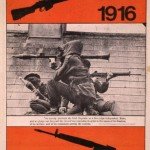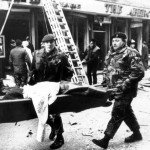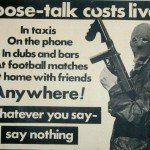
In 1970 the Provisional IRA began recruiting, training and equipping itself for a guerrilla war against British troops in Northern Ireland. It had three objectives: to make Northern Ireland ungovernable; to bring the Unionist government to the brink of collapse; and to force a British withdrawal from the Six Counties. British military commanders sought to ease tensions and starve the Provisional IRA of support by forging friendly relations with Catholic communities. Instead, the British Army’s use of internment, searches and curfews caused its relationship with Catholics to deteriorate. As the situation worsened the Provisional IRA obtained more weapons and recruits. By 1971, the Provos were able to mount a sustained campaign against British and Loyalist targets. This campaign, which lasted until two ceasefires in the mid-1990s, was known by Provisional IRA volunteers as the ‘Long War’.
To drive the British from Northern Ireland
This Long War began with an increase in rioting and sectarian violence in January 1971. On February 3rd British soldiers raided several dozen homes in Catholic areas of Belfast, triggering riots and gun fighting. Three days later an IRA sniper named Billy Reid shot dead Robert Curtis, a 20-year-old British soldier patrolling near New Lodge Road in Belfast. Curtis was the first of almost 300 British Army personnel killed during the Troubles. His death unleashed a wave of violence against British targets. On February 9th five British Broadcasting Corporation (BBC) workmen were killed by an IRA landmine in County Tyrone. Two more British soldiers died in February, along with two Royal Ulster Constabulary (RUC) members. The attacks escalated rapidly in August 1971, in the wake of Operation Demetrius and the internment of suspected Republicans. By the end of 1971, a total of 60 British security personnel had been killed in Northern Ireland.
Worse was to come. The Provisional IRA attacks intensified in early 1972, a response to the Bloody Sunday shootings and the British government’s one-sided Widgery Report. British soldiers on patrol were regularly targeted by drive-by gunfire or snipers concealed in urban areas. The Provisional IRA also made prolific use of explosives. Bombs were hurled at buildings, checkpoints and other stationary targets. Cars belonging to British or Loyalist targets were booby-trapped with charges that exploded on ignition or movement. Abandoned cars were loaded with explosives and detonated as they were being passed or inspected by soldiers. On March 20th the Provisional IRA detonated a large car bomb in Donegall Street, Belfast. The blast killed seven people (two RUC officers, an off-duty soldier and four civilians) and injured almost 150 others, some critically. IRA attacks continued and Northern Ireland spiralled into murderous anarchy.
1972: the deadliest year of the Troubles

Desperate for a solution, British agents convinced the Provisional IRA to announce a temporary ceasefire (June 26th) and participate in secret peace talks. On July 7th several Provisional IRA and Sinn Fein leaders – including Sean Mac Stíofáin, Gerry Adams and Martin McGuinness – traveled to London for talks with Northern Ireland Secretary of State William Whitelaw and other British officials. The meeting was a disaster. Mac Stíofáin was a belligerent and uncompromising negotiator who insisted on the withdrawal of British security forces. Whitelaw refused to make any political assurances that were contrary to the will of the majority of Northern Irelanders. The Provisional IRA ended their ceasefire and in the following fortnight, 13 British soldiers were killed in Ulster. Then, on July 21st, the Provisional IRA launched an astonishing attack in Belfast, detonating 22 car bombs in less than 90 minutes. Dubbed ‘Bloody Friday’, these attacks killed 11 people, most of them civilians in shopping areas, and injured another 130. Ten days later another three car bombs, likely planted by the Provisional IRA in response to Operation Motorman, killed nine people in Claudy, County Londonderry. A total of 479 people would be killed in 1972, the deadliest year of the Troubles; more than half (249) were civilians and more than one-quarter (148) were British soldiers or policemen.
“If we provoked them enough, if we attacked them enough, at some point it wasn’t just us they were going to be shooting at, it was the people… They had to shoot civilians and we knew that. And we agitated and agitated until we got to that situation. We had to move the violence to a new level… We needed the whole situation to be escalated. The thing was always planned.”
Sean O’Hara, IRA volunteer
In the early phase of the Troubles, Provisional IRA leaders believed the British could be forced from Northern Ireland reasonably quickly. They believed that Westminster had no stomach for a long and costly Vietnam-like occupation of Northern Vietnam. The media frenzy following the first British deaths in 1971 seemed to bear this out. The optimism of the Provisional IRA was reflected in its slogans and posters of the early 1970s, promising “Victory 1972” and “Victory 1974”. This underestimated the British government’s resolve and capacity to respond. The British Army launched two missions to suppress Republican paramilitary activity: Operation Demetrius (August 1971) and Operation Motorman (July 1972). While these operations had their difficulties they did succeed in disrupting and weakening the IRA, particularly in its Belfast and Derry strongholds. The British military also worked closely with Special Branch, the RUC’s anti-terrorism unit, which recruited informers, conducted surveillance and gathered intelligence about Republican paramilitary activities. Armed with better information and wide-ranging emergency powers, security forces could better respond to paramilitary violence. Thousands of Republicans were arrested, interrogated and either interned or convicted. These losses weakened the Provisional IRA’s capacity to plan and carry out attacks on security forces, particularly those requiring direct confrontation. The Provisional IRA’s declining impact is reflected in statistics. A total of 148 British security personnel were killed in 1972 alone – but by 1975 this figure had dropped to just 35.
Decentralisation and the 1975 ceasefire

Provisional IRA strategy shifted during the mid-1970s. Lacking the numbers and equipment for major assaults on well equipped and trained British soldiers, Provisional IRA tactics became less conventional and more guerrilla-like. Unwilling to sustain heavy losses, the Provisional IRA began to decentralise. ‘Provo’ volunteers began to operate in small cells, often with just two or three men. IRA leaders provided these cells with a limited amount of information so that captured volunteers could not incriminate or betray others. Missions and assaults were planned to minimise danger and allow an escape route for volunteers. Provisional IRA attacks shifted toward ‘soft targets’ like off-duty British soldiers, RUC officers and prominent Loyalists. This shift in IRA tactics produced a drop in military and police fatalities – but civilian deaths increased, reaching 191 (1974), 174 (1975) and 207 (1976). With British security forces in Northern Ireland now at their strongest, the Provisional IRA initiated its mainland campaign: bombings and terrorist attacks on targets in England. The mainland campaign continued for more than 20 years, claimed 125 lives and cause billions of pounds in damage.
Despite its continued operations, by late 1974 the Provisional IRA was in a parlous state. The organisation was critically short of money, weapons and volunteers. The problem was so severe that some historians have claimed the Provisionals were on the brink of collapse. The group declared a fortnight-long truce over Christmas 1974 that was later extended into the New Year. In February 1975 IRA leaders Billy McKee and Ruairí Ó Brádaigh met with Northern Ireland Secretary of State Merlyn Rees. The two Republicans agreed to a ceasefire, under the assumption that the British would begin a scaled withdrawal of troops from Ulster. London had no intention of withdrawing its units, however, but used the ceasefire to gather intelligence and disrupt the Republican movement. Many within the Provisional IRA considered the 1975 a tactical mistake; the divisions it created allowed Gerry Adams to become a prominent figure within the organisation. By May 1975 Provisional IRA volunteers were again targeting British soldiers and RUC officers.

1. The Long War was a Provisional IRA term describing its military strategy during the mid-1970s. This was in contrast to the early years of the Troubles when a quick victory seemed likely.
2. IRA attacks on British soldiers began in February 1971 and escalated thereafter. The group believed the British had no appetite for a long and costly occupation, though this proved wrong.
3. The breakdown of secret talks in July 1972 saw a rapid increase in IRA violence, beginning with a mass bombing in Belfast (Bloody Friday) that killed 11 people, most of them civilians.
4. Support for the Provisional IRA boomed after Bloody Sunday. An increase in volunteers allowed for an intensification of violence and 1972 proved the deadliest year of the Troubles.
5. The Provisional IRA was much weaker by late 1974. It agreed to a deceptive ceasefire in February 1975 and began adjusting its tactics, adopting a small cell structure, moving toward ‘softer’ targets and initiating a campaign of terrorism in England.

The IRA Green Book: security and commitment (1977)
The IRA Green Book: the enemy (1977)
The IRA Green Book: guerrilla strategy (1977)
NORAID pamphlet calling for donations from Americans (1982)
© Alpha History 2018. Content on this page may not be republished or distributed without our express permission. For more information please refer to our Terms of Use.
This page was written by Rebekah Poole and Jennifer Llewellyn. To reference this page, use the following citation:
R. Poole and J. Llewellyn, “Northern Ireland’s Long War”, Alpha History, accessed [today’s date], https://alphahistory.com/northernireland/northern-ireland-long-war/
